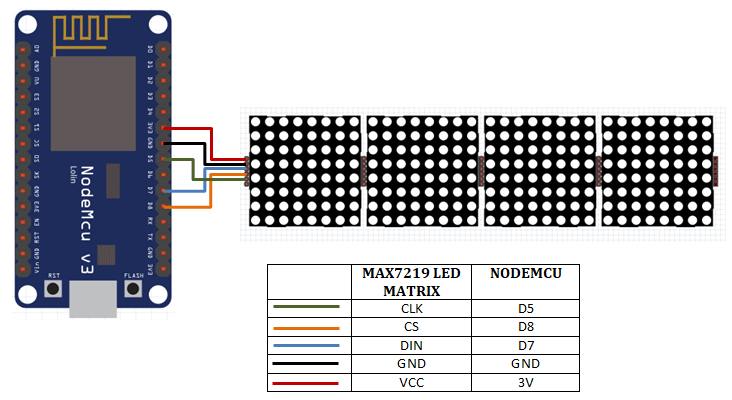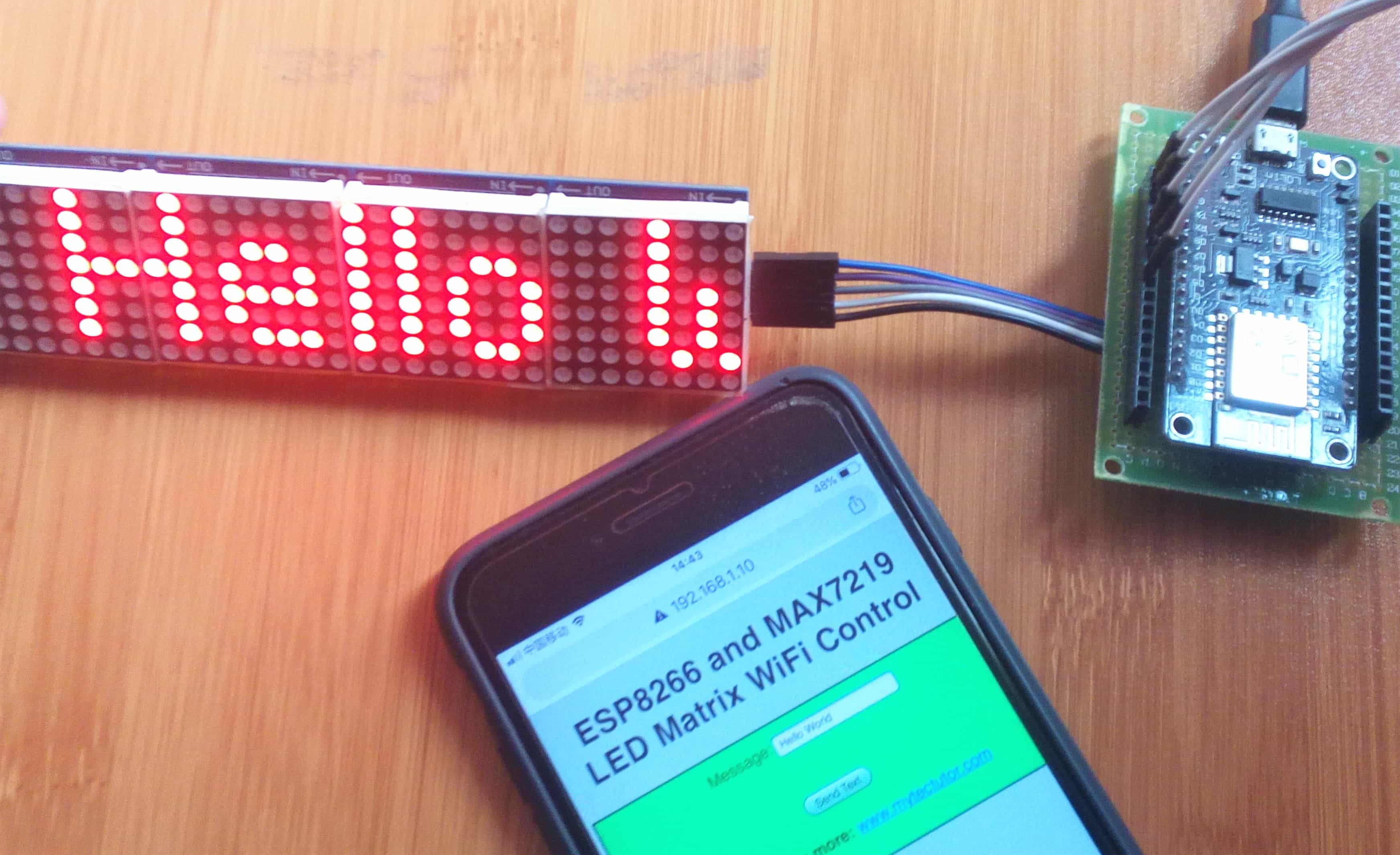One of the uses of the Esp8266 NodeMCU is enabling us to control devices on web pages over a WiFi network. In one of my previous tutorials I showed how to create a web server using NodeMCU;
In this tutorial we want to control scrolling text on the MAX7219 led Matrix display using a custom webpage. Before proceeding you can first learn how to control this type of led matrix using Arduino from the link below:
The Max7219 led matrix display and Esp8266 NodeMCU are connected as shown below. In my case I have used only four led matrices but the setup can accommodate up to eight matrices and can be specified in the code.
Connecting Max7219 LED matrix to ESP8266 NodeMCU.

Code for controlling Max7219 Led matrix with Esp8266 NodeMCU over WiFi.
This code includes the ESPWiFi.h for enabling the Nodemcu to create a webserver over a Wifi network, the MD_MAX72xx.h for controlling the Led matrix. Take time to learn how this library works with the display before proceeding.
You can also change the design and appearance of the web page by changing the HTML and CSS part of the code but only do this if you have prior knowledge on web development and design otherwise the web page may not be displayed!
#include <ESP8266WiFi.h>
#include <MD_MAX72xx.h>
#include <SPI.h>
#define PRINT_CALLBACK 0
#define DEBUG 0
#define LED_HEARTBEAT 0
#if DEBUG
#define PRINT(s, v) { Serial.print(F(s)); Serial.print(v); }
#define PRINTS(s) { Serial.print(F(s)); }
#else
#define PRINT(s, v)
#define PRINTS(s)
#endif
#if LED_HEARTBEAT
#define HB_LED D2
#define HB_LED_TIME 500 // in milliseconds
#endif
// Define the number of devices we have in the chain and the hardware interface
/ NOTE: These pin numbers will probably not work with your hardware and may
// need to be adapted
#define MAX_DEVICES 4
#define CLK_PIN D5 // or SCK
#define DATA_PIN D7 // or MOSI
#define CS_PIN D8 // or SS
// SPI hardware interface
//MD_MAX72XX mx = MD_MAX72XX(CS_PIN, MAX_DEVICES);
#define HARDWARE_TYPE MD_MAX72XX::FC16_HW //edit this as per your LED matrix hardware type
MD_MAX72XX mx = MD_MAX72XX(HARDWARE_TYPE, CS_PIN, MAX_DEVICES);
// Arbitrary pins
//MD_MAX72XX mx = MD_MAX72XX(DATA_PIN, CLK_PIN, CS_PIN, MAX_DEVICES);
// WiFi login parameters - network name and password
const char* ssid = "wifi SSID"; // edit your wifi SSID here
const char* password = "wifi password"; // edit your wifi password here
// WiFi Server object and parameters
WiFiServer server(80);
// Global message buffers shared by Wifi and Scrolling functions
const uint8_t MESG_SIZE = 255;
const uint8_t CHAR_SPACING = 1;
const uint8_t SCROLL_DELAY = 75;
char curMessage[MESG_SIZE];
char newMessage[MESG_SIZE];
bool newMessageAvailable = false;
char WebResponse[] = "HTTP/1.1 200 OK\nContent-Type: text/html\n\n";
char WebPage[] =
"<!DOCTYPE html>" \
"<html>" \
"<head><meta name=\"viewport\" content=\"width=device-width, initial-scale=1\">" \
"<title>MYTECTUTOR ESP8266 AND MAX7219</title>" \
"<style>" \
"html, body" \
"{" \
"font-family: Helvetica; "\
"display: block;"\
"margin: 0px auto;"\
"text-align: center;"\
"background-color: #cad9c5;" \
"}" \
"#container " \
"{" \
"width: 100%;" \
"height: 100%;" \
"margin-left: 5px;" \
"margin-top: 20px;" \
"border: solid 2px;" \
"padding: 10px;" \
"background-color: #2dfa53;" \
"}" \
"</style>"\
"<script>" \
"strLine = \"\";" \
"function SendText()" \
"{" \
" nocache = \"/&nocache=\" + Math.random() * 1000000;" \
" var request = new XMLHttpRequest();" \
" strLine = \"&MSG=\" + document.getElementById(\"txt_form\").Message.value;" \
" request.open(\"GET\", strLine + nocache, false);" \
" request.send(null);" \
"}" \
"</script>" \
"</head>" \
"<body>" \
"<H1><b>ESP8266 and MAX7219 LED Matrix WiFi Control</b></H1>" \
"<div id=\"container\">"\
"<form id=\"txt_form\" name=\"frmText\">" \
"<label>Message:<input type=\"text\" name=\"Message\" maxlength=\"255\"></label>%ltbr><br>" \
"</form>" \
"<br>" \
"<input type=\"submit\" value=\"Send Text\" onclick=\"SendText()\">" \
"<p><b>Visit link for more: </b>" \
"<a href=\"https://www.mytectutor.com\">www.mytectutor.com</a></p>" \
"</div>" \
"</body>" \
"</html>";
char *err2Str(wl_status_t code)
{
switch (code)
{
case WL_IDLE_STATUS: return("IDLE"); break; // WiFi is in process of changing between statuses
case WL_NO_SSID_AVAIL: return("NO_SSID_AVAIL"); break; // case configured SSID cannot be reached
case WL_CONNECTED: return("CONNECTED"); break; // successful connection is established
case WL_CONNECT_FAILED: return("CONNECT_FAILED"); break; // password is incorrect
case WL_DISCONNECTED: return("CONNECT_FAILED"); break; // module is not configured in station mode
default: return("??");
}
}
uint8_t htoi(char c)
{
c = toupper(c);
if ((c >= '0') && (c <= '9')) return(c - '0');
if ((c >= 'A') && (c <= 'F')) return(c - 'A' + 0xa);
return(0);
}
boolean getText(char *szMesg, char *psz, uint8_t len)
{
boolean isValid = false; // text received flag
char *pStart, *pEnd; // pointer to start and end of text
// get pointer to the beginning of the text
pStart = strstr(szMesg, "/&MSG=");
if (pStart != NULL)
{
pStart += 6; // skip to start of data
pEnd = strstr(pStart, "/&");
if (pEnd != NULL)
{
while (pStart != pEnd)
{
if ((*pStart == '%') && isdigit(*(pStart+1)))
{
// replace %xx hex code with the ASCII character
char c = 0;
pStart++;
c += (htoi(*pStart++) << 4);
c += htoi(*pStart++);
*psz++ = c;
}
else
*psz++ = *pStart++;
}
*psz = '\0'; // terminate the string
isValid = true;
}
}
return(isValid);
}
void handleWiFi(void)
{
static enum { S_IDLE, S_WAIT_CONN, S_READ, S_EXTRACT, S_RESPONSE, S_DISCONN } state = S_IDLE;
static char szBuf[1024];
static uint16_t idxBuf = 0;
static WiFiClient client;
static uint32_t timeStart;
switch (state)
{
case S_IDLE: // initialise
PRINTS("\nS_IDLE");
idxBuf = 0;
state = S_WAIT_CONN;
break;
case S_WAIT_CONN: // waiting for connection
{
client = server.available();
if (!client) break;
if (!client.connected()) break;
#if DEBUG
char szTxt[20];
sprintf(szTxt, "%03d:%03d:%03d:%03d", client.remoteIP()[0], client.remoteIP()[1], client.remoteIP()[2], client.remoteIP()[3]);
PRINT("\nNew client @ ", szTxt);
#endif
timeStart = millis();
state = S_READ;
}
break;
case S_READ: // get the first line of data
PRINTS("\nS_READ");
while (client.available())
{
char c = client.read();
if ((c == '\r') || (c == '\n'))
{
szBuf[idxBuf] = '\0';
client.flush();
PRINT("\nRecv: ", szBuf);
state = S_EXTRACT;
}
else
szBuf[idxBuf++] = (char)c;
}
if (millis() - timeStart > 1000)
{
PRINTS("\nWait timeout");
state = S_DISCONN;
}
break;
case S_EXTRACT: // extract data
PRINTS("\nS_EXTRACT");
// Extract the string from the message if there is one
newMessageAvailable = getText(szBuf, newMessage, MESG_SIZE);
PRINT("\nNew Msg: ", newMessage);
state = S_RESPONSE;
break;
case S_RESPONSE: // send the response to the client
PRINTS("\nS_RESPONSE");
// Return the response to the client (web page)
client.print(WebResponse);
client.print(WebPage);
state = S_DISCONN;
break;
case S_DISCONN: // disconnect client
PRINTS("\nS_DISCONN");
client.flush();
client.stop();
state = S_IDLE;
break;
default: state = S_IDLE;
}
}
void scrollDataSink(uint8_t dev, MD_MAX72XX::transformType_t t, uint8_t col)
// Callback function for data that is being scrolled off the display
{
#if PRINT_CALLBACK
Serial.print("\n cb ");
Serial.print(dev);
Serial.print(' ');
Serial.print(t);
Serial.print(' ');
Serial.println(col);
#endif
}
uint8_t scrollDataSource(uint8_t dev, MD_MAX72XX::transformType_t t)
// Callback function for data that is required for scrolling into the display
{
static enum { S_IDLE, S_NEXT_CHAR, S_SHOW_CHAR, S_SHOW_SPACE } state = S_IDLE;
static char *p;
static uint16_t curLen, showLen;
static uint8_t cBuf[8];
uint8_t colData = 0;
// finite state machine to control what we do on the callback
switch (state)
{
case S_IDLE: // reset the message pointer and check for new message to load
PRINTS("\nS_IDLE");
p = curMessage; // reset the pointer to start of message
if (newMessageAvailable) // there is a new message waiting
{
strcpy(curMessage, newMessage); // copy it in
newMessageAvailable = false;
}
state = S_NEXT_CHAR;
break;
case S_NEXT_CHAR: // Load the next character from the font table
PRINTS("\nS_NEXT_CHAR");
if (*p == '\0')
state = S_IDLE;
else
{
showLen = mx.getChar(*p++, sizeof(cBuf) / sizeof(cBuf[0]), cBuf);
curLen = 0;
state = S_SHOW_CHAR;
}
break;
case S_SHOW_CHAR: // display the next part of the character
PRINTS("\nS_SHOW_CHAR");
colData = cBuf[curLen++];
if (curLen < showLen)
break;
// set up the inter character spacing
showLen = (*p != '\0' ? CHAR_SPACING : (MAX_DEVICES*COL_SIZE)/2);
curLen = 0;
state = S_SHOW_SPACE;
// fall through
case S_SHOW_SPACE: // display inter-character spacing (blank column)
PRINT("\nS_ICSPACE: ", curLen);
PRINT("/", showLen);
curLen++;
if (curLen == showLen)
state = S_NEXT_CHAR;
break;
default:
state = S_IDLE;
}
return(colData);
}
void scrollText(void)
{
static uint32_t prevTime = 0;
// Is it time to scroll the text?
if (millis() - prevTime >= SCROLL_DELAY)
{
mx.transform(MD_MAX72XX::TSL); // scroll along - the callback will load all the data
prevTime = millis(); // starting point for next time
}
}
void setup()
{
#if DEBUG
Serial.begin(115200);
PRINTS("\n[MD_MAX72XX WiFi Message Display]\nType a message for the scrolling display from your internet browser");
#endif
#if LED_HEARTBEAT
pinMode(HB_LED, OUTPUT);
digitalWrite(HB_LED, LOW);
#endif
// Display initialisation
mx.begin();
mx.setShiftDataInCallback(scrollDataSource);
mx.setShiftDataOutCallback(scrollDataSink);
curMessage[0] = newMessage[0] = '\0';
// Connect to and initialise WiFi network
PRINT("\nConnecting to ", ssid);
WiFi.begin(ssid, password);
while (WiFi.status() != WL_CONNECTED)
{
PRINT("\n", err2Str(WiFi.status()));
delay(500);
}
PRINTS("\nWiFi connected");
// Start the server
server.begin();
PRINTS("\nServer started");
// Set up first message as the IP address
sprintf(curMessage, "%03d:%03d:%03d:%03d", WiFi.localIP()[0], WiFi.localIP()[1], WiFi.localIP()[2], WiFi.localIP()[3]);
PRINT("\nAssigned IP ", curMessage);
}
void loop()
{
#if LED_HEARTBEAT
static uint32_t timeLast = 0;
if (millis() - timeLast >= HB_LED_TIME)
{
digitalWrite(HB_LED, digitalRead(HB_LED) == LOW ? HIGH : LOW);
timeLast = millis();
}
#endif
handleWiFi();
scrollText();
}

When the above code is uploaded to the Nodemcu, the URL can be checked from the serial monitor and can be used to access the web page for controlling the text being displayed on the MAX7219 Led diaplay.
From this web page we can enter a message and that message will be displayed on the matrix.

